Archive
Ultimate Shepherd’s Pie
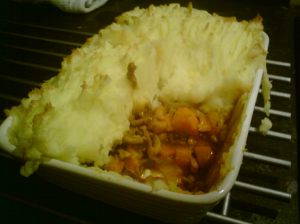
Autumn has truly arrived, and, although I’ve said before that bright sunshine and soaring temperatures won’t always stop me from cooking something warming, hearty and wintery, the time is definitely right for cooking food like this. I’ve called it my ‘ultimate’ shepherd’s pie, because, for me, I don’t think this recipe can be improved upon, so much so we’ve had this for dinner four times in two weeks!
Some might argue that what I’m making is actually a cottage pie, in that I use minced beef rather than minced lamb, as per the traditional shepherd’s pie, but, frankly, the distinction is irrelevant. What matters more is eating what tastes good, so if you prefer lamb, use it. I’ve made this with vegetarian ‘mince’ too, admittedly to cater for vegetarian friends rather than out of choice, but it worked just fine. I swapped the stock for vegetable, (and in actual fact I’ve more often than not been using chicken rather than perhaps more orthodox beef stock anyway, so I don’t think it’s too important) but, my friends not being too fussy vegetarians, allowed me to keep my Worcestershire sauce. If you needed to make this truly vegetarian, I suspect you could use some good soy sauce instead to impart some of the colour and saltiness of the Worcestershire, if not the exact same depth of flavour.
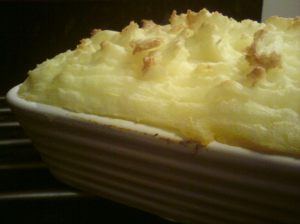
While we’re talking about flavour, you’ll see I’ve added celery salt too. It struck me that, with a base of carrots and onions, celery would work here too, that trio of classic ingredients which is the base of many a delicious stock, so do add a finely diced stick or two if you’d like. The first time I made this, I didn’t have any in the house, so added some celery salt instead, adding a hint of the flavour and aroma of celery, and was so pleased with the result I’m reluctant to change now. Which brings me to the baked beans. Perhaps not traditional, although certainly the bringing together of two quite British traditions, but definitely worth a try. If you truly cannot abide the thought, perhaps substitute with the same quantity of good quality tinned chopped tomatoes.
The recipe I’ve given below is for two, although, as ever with my cooking, this could potentially serve more, less greedy people, especially with more vegetables on the side. The quantities here fill a 15 x 25 x 4cm approx dish, with the mashed potato topping mounded way above the top of the vessel. My point is, 900g of potatoes may seem a lot for two people, (and again, it could well be for two other people), but this means the pie is dinner for two by itself, no need for extras, although what I think is childhood nostalgia encourages me to generally serve this with an equally oversized portion of peas. The recipe is easily doubled, should you need, and I have previously successfully frozen a completed pie, mash and all, but without it’s final time in the oven, defrosting well (24 hours in the fridge should do it) and then cooking for maybe 40 minutes in a 200°C oven until piping hot all the way through, so why not make two?
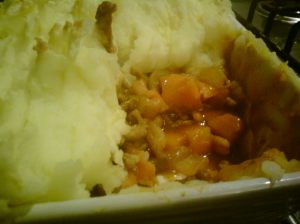
Ultimate Shepherd’s Pie (serves 2, and see above)
- 2 medium onions, diced
- 2 medium carrots, diced
- 1 clove garlic, finely chopped
- 1 tablespoon vegetable oil
- 250g minced beef
- 2 tablespoons tomato puree
- Half a 400g tin baked beans
- 1 tablespoon Worcestershire sauce
- Half a teaspoon celery salt
- 1 tablespoon flour
- 250ml chicken stock
- 900g potatoes, peeled and cut into 2.5 cm chunks
- A good dollop of butter
Put the potatoes into a large pan of boiling, well salted water, cover, and boil until tender, more than tender in fact, until you’re sure there’ll be no little pieces of uncooked, hard potato hiding in the centre of your chunks. 25 minutes, maybe more.
Meanwhile, heat the tablespoon of vegetable oil in a large pan, and add the onions, carrots and garlic. Stir them around in the oil, put a lid on the pan, and sweat over a medium heat for 10 minutes. Preheat the oven to 200°C.
Add the minced beef to the vegetables, and fry until just browned. A wooden (or suitable plastic) fork is, I think, the best way to fry mince, as it breaks up any clumps as it moves the mince around. Add the tomato puree, and continue stirring, until it’s well distributed, and in any case for at least a minute. Add the baked beans, Worcestershire sauce and celery salt, and give everything a good stir. Add the flour, and give everything a final stir to ensure the flour is well mixed in. Pour over the stock, bring to the boil and simmer for 15-20 minutes, stirring occasionally. I’m aiming for a quite thick, barely-there sauce, with all the flavours concentrated and absorbed by the meat and vegetables.
Meanwhile, when the potatoes are done, mash them (I like using my potato ricer to get a really smooth mash, for much larger quantities I would beat the potatoes to mash with an electric hand whisk, but do as you wish, trying your best to ensure no lumps), and stir in the butter, adding a little salt if needed, to taste.
Pour the cooked minced beef into a suitable oven proof dish, and top with the mashed potato. Spread the potato over the mince with a silicone spatula, sealing in the filling. Mark deep grooves into the top of the mash, using the tines of a fork and bake in the oven for 20 minutes, or until the ridges you’ve made in the mash are slightly crunchy.
Strawberry Cheesecake Cupcakes
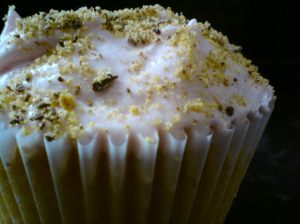
I’m not sure if this says more about my shopping than my cooking habits, but I seem to be forever coming up with ways to use up leftover mascarpone. Of course, depending on how you look at it, this isn’t a bad thing since these new inventions are usually sweet treats.
Overwhelmed with new cupcake recipes and techniques this month, from my recent book purchase, and a feature in this month’s Sainsbury’s Magazine, I drew inspiration from these and elsewhere, but ended up going my own way. In this case, these are plain vanilla cupcakes with a light and creamy strawberry-cheesecake-esque topping. Sometimes, I do think that vanilla cupcakes are the way to go, if you’re adding a good frosting, since, if nice and moist, they offer a comfortingly bland yet satisfying backdrop to a delicious topping. Although, having said that, on any given day I’m equally likely to make flavoured cupcakes that complement their frosting – one of the best things about these pretty little treats is they’re so adaptable, to what you have in the house, to a special event, and not least to your current mood.

This is a fairly standard cupcake mixture, which made enough for 9 muffin cases, my preference for cupcakes, but would equally, with the cooking time adjusted, make 12 smaller but perfectly formed cakes in standard cases. The frosting is, of course, adaptable – cupcakes seem to be the thing right now, and I reckon more recipes I see seem to call for a cream cheese frosting, so mascarpone wasn’t much of a stretch, since I had it anyway, and although I think this adds more of a cheesecake-yness, if you will, you could use Philadelphia-type soft cream cheese, full fat please, if you so wish.
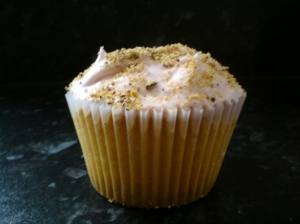
Strawberry Cheesecake Cupcakes (makes 9)
- 100g butter
- 100g caster sugar
- 2 eggs
- 1 teaspoon vanilla extract
- 1 tablespoon milk
- 100g self raising flour
For the Strawberry Cheesecake Frosting
- 125g mascarpone (at room temperature)
- 50g butter (at room temperature)
- 225g icing sugar
- 2 tablespoons strawberry jam
- a little pink food colouring (optional)
- 2 digestive biscuits (optional)
Preheat the oven to 180°C and line 9 holes of a muffin tray with muffin cases (or 12 holes with smaller fairy cake cases).
Put the butter and sugar into a bowl, and cream together until pale and fluffy, with an electric handwhisk or mixer.
Continuing to beat, add an egg, until incorporated, then a spoonful of the flour, incorporate, then the final egg, and incorporate that too. (Adding the eggs one at a time, with a spoonful of flour between, reduces the chance of the batter curdling.) Finally, add the vanilla and milk and beat some more.
Add the flour, and mix in well, but briefly, either with your mixer on a low speed or by hand, since overworking the batter once the flour is added may affect the rising of your cakes.
Divide the mixture between the waiting cases, ensuring they are not more than two thirds full. Bake for 20-25 minutes, checking at 20, until the sponge is lightly golden, springs back if you gently touch it, and/or an inserted skewer or similar emerges clean. Cool in the tin for 10 minutes, and then transfer to a wire rack to cool completely.
While the cakes are cooling, or even while they’re baking, make your frosting. Put the mascarpone, butter and icing sugar into a bowl, and beat together, slowly at first, and even if completing the job power-assisted, I would start of with a spoon to avoid the dust-cloud of icing sugar you may otherwise get. Once combined, turn up the mixer and continue beating until quite light and fluffy.
Force the jam through a sieve with the back of a spoon, and then scrape the now bit-free jam from the reverse of the sieve. Add this to the frosting, beat it through, and then taste, and add a little more jam if you think you need it. If you wish to add a little pink food colouring, do so now, and again beat, until you have an even colour. If your frosting seems too runny, add a little extra icing sugar, and then chill in the fridge until your cupcakes are completely cold and ready to be iced – this will also help the frosting firm up a little after all of the beating.
When you’re ready, top the cupcakes with the frosting. Bash, whizz or otherwise pulverise the digestive biscuits into crumbs, and scatter over to decorate. These will keep in a sealed container, in the fridge if its warm, for a couple of days, although do please bring them back to room temperature to eat.
Lime Cupcakes
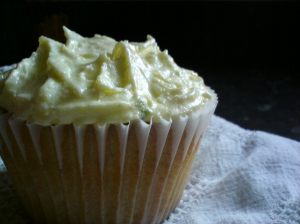
I recently treated myself to the Hummingbird Bakery Cookbook, sold mostly on the pictures of the amazing cakes within. When I googled it, I was intrigued by the mixed reviews of this book all over the internet, some people rave about it, others complain they cannot get the recipes to work.
Admittedly, the cupcake recipes are unusual for the seasoned baker – no creaming of butter and sugar, and ingredients in different amounts (as opposed to the usual equal parts flour, sugar, eggs and butter). However, the book promises, if you follow the instructions, you’ll end up with the desired result.
With baking, it’s best to follow instructions anyway, as it’s a little more science-y than other cooking, and I usually follow instructions at least the first time, before I start playing with flavours and the like. Here, the only change I made was to substitute lemon for lime, as I had some limes that needed using, and I do love the flavour of lime.
The recipe said I would get 12 cupcakes from the mixture, although I only got nine, and even then was worried these wouldn’t fill their cases on baking since the mixture looked a little scant – the cases should be two-thirds full. However, I did get flat-topped cupcakes, something I wouldn’t have achieved if I’d tried, so they would have been good for runny, glace icing. And the shortfall was lucky really, as I suspect the frosting recipe wouldn’t have stretched to 12 either.
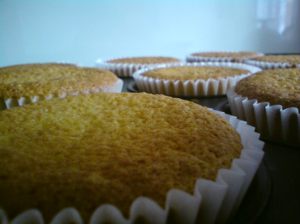
It’s also worth pointing out, for us in the UK, you need the larger paper cases for these, the ones sold as ‘muffin cases’. Well, who could complain about bigger cupcakes anyway? The end result was good – nice moist sponge, sharp yet sweet lime frosting (which I would definitely adapt and use elsewhere!) – so overall, I’m pleased and can’t wait to make more from the book.
Recipe based on The Hummingbird Bakery Cookbook’s Lemon Cupcakes
Lime Cupcakes (makes 9)
- 120g plain flour
- 150g caster sugar
- 1 1/2 teaspoons baking powder
- 2 tablespoons lime zest
- 40g unsalted butter
- 120ml whole milk
- 1 egg
For the lime frosting:
- 250g icing sugar, sifted
- 80g unsalted butter
- 2 tablespoons lime zest
- a couple of drops of food colouring (optional – I used a touch of yellow)
- 25ml whole milk
Preheat the oven to 170°C, and, as ever, ensure your baking ingredients are at room temperature. Especially the butter. Place 9 muffin cases into a cupcake/muffin tray.
Put the flour, sugar, baking powder, lime zest and butter in a mixing bowl, and beat, on a fairly slow speed, with a handheld electric whisk (or, if you’re lucky enough to have one, a freestanding electric mixer with a paddle or beater attachment) until everything is combined, and you have a kind of sandy consistency.
Still beating, gradually add the milk. When incorporated, add the egg. Continue to mix for a minute or two more, until everything is smooth, but don’t overwork it. While you’re mixing, you may need to push in any unmixed ingredients from the side of the bowl with a silicone spatula.
Spoon the batter into the cases until they’re two thirds full at most. Bake for 20-25 minutes, or until the sponge bounces back when touch. A cake tester or skewer poked in the middle should come out clean. Leave the cupcakes to cool in the tin for five minutes before placing onto a wire rack to cool completely.
To make the frosting, beat together the icing sugar, butter, lime zest, and colouring if using, again using either an electric whisk or a handheld mixer, on a slow to medium speed, until well mixed and coming together. With the mixer on a slow speed, add the milk slowly, and when everything is incorporated, turn the mixer up to a high speed. Carry on beating until the mixture is light and fluffy, for at least five minutes, but, apparantly, the longer you go, the lighter and fluffier the frosting gets.
When the cupcakes are completely cold, spoon the frosting on top. Allow the frosting to set a little before serving.
A Bit of a Different Sweet & Sour Sauce
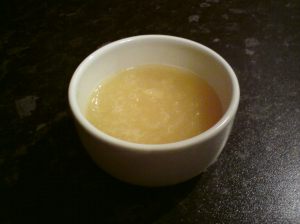
Continuing with the sweet & sour mini-series I seem to have going today, this is the first of two sweet and sour sauces. This is the one from Chinese Food Made Easy that goes with the original Sweet & Sour Pork recipe. It’s different from the traditional, but really light and refreshing, and goes very well with the slightly spicy crunchy coated pork. Do try this, but if you prefer the usual, orange coloured, tangy, sugary style sauce, then try this too.
I used to find it difficult to find Shaoxing rice wine, not having a good chinese supermarket nearby, but have discovered Waitrose sell one as part of their ‘Cook’s Ingredients’ range, but dry pale sherry is a perfectly fine substitute.
Recipe from Ching-He Huang’s Chinese Food Made Easy
A Bit of a Different Sweet & Sour Sauce (serves 2)
- 125g tinned pineapple (in natural juice, not syrup)
- 125ml pineapple juice (from the tin is fine!)
- 3 tablespoons lime juice (freshly squeezed is best, but I have used the bottled stuff)
- 1 tablespoon light soy sauce
- 1 tablespoon Shaoxing rice wine (or dry sherry)
- a pinch of ground white pepper
Put the pineapple, pineapple juice and lime juice into a blender, a blitz, but not too much, until you have a smooth-ish sauce – I like mine a little ‘pulpy’.
Transfer to a saucepan, bring to the boil and then simmer for 2 minutes or so, until the sauce reduces and thickens a little. Season to taste with the soy sauce, rice wine and pepper. Simmer for a further minute and then serve with crunchy coated pork, chicken or turkey, over egg fried rice.
Chinese Takeaway Style Sweet & Sour Sauce
There are lots of different recipes for sweet & sour sauce, and I’ve tried lots of variations in a, possibly a little sad, mini-quest for perfection, by which I suppose I mean one that best approximates my favourite takeaway’s sauce that I can easily make at home. While I’m certainly not saying this is the definitive sweet & sour sauce, I think it’s pretty good. Drawing inspiration from all over, not least this recipe, this is quite a good approximation of the thick, sticky orange sauce we all know and love.
Ok, the list of ingredients is quite long, but stick with it, it’s worth it, and you may have most of the storecupboard stuff in anyway if you cook Chinese food a lot, or will end up amassing it if you plan to. I’ve suggested pineapple, red peppers and water chestnuts to make a chunky sauce, but play around as you wish. Tinned pineapple is fine, and water chestnuts you can buy either tinned or vacuum packed. In both cases, I’ve successfully frozen the leftover contents of the packages for use another time.
Chinese Takeaway Style Sweet & Sour Sauce (serves 2)
- 1 teaspoon toasted sesame oil
- 1 clove garlic, finely chopped
- 1 x 2cm piece root ginger, peeled and grated
- 2 tablespoons light soy sauce
- 1 tablespoon white wine vinegar
- 1 tablespoon rice vinegar
- 2 tablespoons tomato ketchup
- 4 tablespoons pineapple juice
- 1 tablespoon soft, light brown sugar
- 2 tablespoons clear honey
- 2 tablespoons sweet chilli sauce
- pinch of salt and ground white pepper
- 1 tablespoon cornflour, stirred well into 4 tablespoons water
- 50g pineapple chunks
- 50g water chestnuts, sliced
- 1 small red pepper, cut into chunks
Heat the toasted sesame oil in a small saucepan, and then add the garlic and ginger. Stir fry for about 30 seconds. Add the soy sauce, vinegars, ketchup, pineapple juice, sugar, honey and sweet chilli sauce. Stir everything together well.
Season with a pinch of salt and ground white pepper, and then simmer for a minute or so. Stir in the cornflour mixture, and stir, over the heat, until the sauce begins to thicken a little.
Add the pineapple, red pepper and water chestnuts, and cook for 1 – 2 minutes, until everything is heated through. Serve with crunchy coated pork, chicken or turkey, over egg fried rice.
Sweet & Sour Crunchy Coated Pork (or Chicken, or Turkey)

Returning, once more, to Ching-He Huang’s Chinese Food Made Easy, this is the first meal I cooked from the book. Everyone loves sweet & sour, no? So, this is my adaption of this recipe, and I think the crunchy coated meat would work in a number of dishes, so I’ll post separately two ideas for a sweet & sour sauce.
Recipe adapted from Ching-He Huang’s Chinese Food Made Easy
Sweet & Sour Crunchy Coated Pork (or Chicken, or Turkey) (serves 2)
- 2 pork loin steaks, fat removed, or 2 chicken breasts, or 2 turkey breast steaks
- 6 tablespoons dry roasted peanuts, or the same amount of whole roasted soya beans and a pinch of salt
- a pinch of ground white pepper
- 1/2 – 1 teaspoon dried red chilli flakes (to taste)
- 2 tablespoons ground nut oil
Place your meat between two sheets of clingfilm on a suitable surface, and then bash with a rolling pin or other appropriate instrument until it’s about half the thickness it was. Cut the meat into large chunks (or leave as whole, large steaks if you wish).
Next, make the crunchy coating for the meat. Tip the peanuts and chilli flakes into a mini-chopper or food processor, and a pinch of ground white pepper, a blitz to a coarsely ground coating.
Pour the coating onto a plate or shallow dish, and then firmly press each side of the meat pieces into the crumbs until well coated.
Heat the ground nut oil in a large frying pan, or wok, and cook for 2-3 minutes on each side, until thoroughly cooked. Serve with this fresh modern take on sweet & sour sauce, or this more traditional takeaway-style one, and egg fried rice.
Egg Fried Rice with Tomatoes
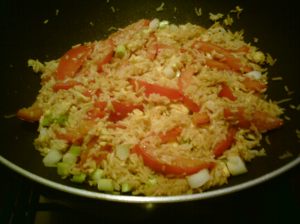
I just love Chinese food, with its wonderful flavours, and quick, easy cooking. I’ve already talked about Ching He-Huang’s Chinese Food Made Easy, which, I think, is a fantastic book, and has encouraged me to try some Chinese cooking at home, and the results have always been great. Cooking Chinese food at home really isn’t too difficult, and much better for your waistline and wallet than ordering takeaway!
I’m going to post a couple of sweet & sour recipes later, but thought I’d start with egg fried rice, as it is my favourite side dish to a Chinese meal, and really goes well with sweet & sour! This recipe is adapted from the Beijing Rice in Chinese Food Made Easy. I’ve reduced the amount of rice, and I think what I’ve suggested is enough of a side for two people, although I haven’t reduced the amount of seasoning, particularly the toasted sesame oil, as this is simply one of my favourite flavours – by all means reduce the amount slightly, or increase the rice up to about 400g, as my preference is for this rice is to have it really flavour-packed, if a touch oily. By all means, change the vegetables too. I love the crunch of the spring onion added in at the end, so my recipe calls for more than the original.
When making egg fried rice, you need to have cooked rice, and its easier to do this the day before, but do bear in mind you need drain it well, cool it quickly, refrigerate it and ensure it is fully reheated. If that all seems like a bit of a hassle, then you can cheat! This rice, and others like it, are designed for microwaving but are basically little packages of cooked rice, in a little oil to stop it sticking, that stir fry really well. I use it all the time, and would use one 280g packet in place of the 300g cooked rice in this recipe. It’s best to break it up in a bowl before you add it to the wok.
Recipe adapted from Ching-He Huang’s Chinese Food Made Easy
Egg Fried Rice with Tomatoes (serves 2)
- 1 – 2 tablespoons ground nut oil
- 2 eggs, beaten
- 300g cooked jasmine rice
- 3 tomatoes, de-seeded and sliced
- 2-3 tablespoons light soy sauce
- 2-3 teaspoons toasted sesame oil
- pinch of ground white pepper
- 4 – 5 spring onions, finely sliced
Heat a wok until very hot, and then add a tablespoon of ground nut oil. When the oil is hot, add the eggs and scramble for a minute or two, until just cooked. You should probably remove the eggs at this point, and set aside to be re-added later, but I’ve never bothered and haven’t really noticed it being overdone.
If needed, add another tablespoon of ground nut oil to the wok. Tip in the rice, and stir fry for a minute, then add the tomatoes and stir fry for a further 3-4 minutes.
If you’ve removed the egg, stick it back in at this point. Season, to taste, with the soy sauce, toasted sesame oil and pepper, and then add the spring onions. Give everything a final stir, and serve immediately.
Smoky Chicken & Bean Stew
Ok, I admit it, I’m perhaps a little obsessed with chorizo. Honestly, not every meal I cook is based around this spicy little Spanish number, but it is really useful – it’s really tasty, adds great flavour to dishes, and goes well with other ingredients I seem to be using a lot right now, like chicken, red peppers, beans and tomatoes, all of which lend themselves to easy, one-pot stews like this.
I’m quite a new convert to chicken thighs. I was never this biggest fan of the dark meat from chicken, and convinced myself that breast meat was best, but thighs are great. They’re full of flavour, much more so than breast meat, and tend not to try out so much. And, they’re cheaper to boot.
You could maybe spice things up here by adding a finely chopped, de-seeded red chilli. As ever, chicken stock from good quality bouillon concentrate is fine.
Smoky Chicken & Bean Stew (serves 2)
- 1 red onion, sliced
- 2 cloves garlic, finely chopped
- 1 tablespoon olive oil
- 1 tablespoon smoked paprika
- 1 red pepper, de-seeded and roughly chopped into chunks
- 4 boneless, skinless chicken thighs, each cut into 3-4 strips
- 100g chorizo, sliced into coins and then each slice halved
- 4 tomatoes, de-seeded and roughly chopped
- 1 x 400g tin borlotti beans, rinsed and drained
- 300ml chicken stock
- 15g fresh coriander, roughly chopped (about half of a standard supermarket packet)
Heat 1 tablespoon of oil in a large pan or suitable casserole dish, and throw in the onions and garlic. Cook for 3-5 minutes until softened, but not brown. Add the smoked paprika and red pepper, stir well and cook for another 2 minutes.
Add the chorizo and chicken to the pan, and fry for 5 minutes, until the chicken is browned and the chorizo is releasing its fat.
Add the tomatoes and beans, and then pour over the chicken stock. Bring to the boil and then simmer for 20 minutes, until the sauce has thickened and the chicken is completely cooked.
Scatter over the coriander. Serve with warmed pitta breads.
Nigella’s Hot Chocolate Sauce
Having a quick and easy chocolate sauce in your repertoire is really useful for all manner of things. Hot fudge sundaes, of course, tarting up shop bought ice cream, a fabulous dip for fresh fruit, or for pouring over a hot chocolate pudding, in place of, or better still in addition to, ice cream or cream. And, of course, for this.
This is my standby chocolate sauce of choice, from Nigella Express. Firstly, don’t be alarmed by the addition of Camp coffee (a thick syrup of coffee, sugar and chicory used to make a no-doubt vile instant coffee drink, but extremely useful in cooking) or strong espresso, this doesn’t make it a coffee-chocolate sauce, but adds a real depth of flavour and richness to the sauce. The golden syrup, meanwhile, makes everything glossy and shiny, and who could argue with that?
Nigella’s Hot Chocolate Sauce (likely enough to generously pour over 4 puddings, at least)
- 75g dark chocolate (70%)
- 125ml double cream
- 2 tablespoons Camp coffee, or 2 teaspoons instant espresso powder dissolved in 2 tablespoons hot water
- 1 tablespoon golden syrup
Break up the chocolate into a heavy based saucepan, and add the cream, coffee and syrup. Melt slowly over a low heat, stirring, until everything is melted and combined. Pour into a jug or other suitable vessel from which to pour over your pudding.
Hot Flapjack Pudding and Ice Cream
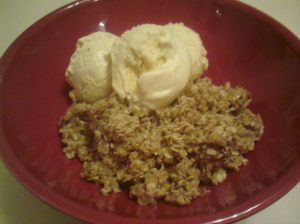
For some people, the best part of making a cake batter is licking the bowl. For others, cookie dough is a foodstuff in its own right. This is, then, perhaps inspired by that idea. It stemmed from a light night craving for a hot pudding, but also a desire for something quick and easy that didn’t need any shopping. Essentially unbaked flapjack mixture served warm, with good, shop-bought vanilla ice cream, it would be a stretch to call this a recipe, and, unusually for me as I don’t often use it, the cooking instructions are for the microwave, although if that is a little déclassé for you, then by all means use a large saucepan over a low heat.
I’ve written quantities below, but usually I would just guess – throw a chunk of butter in the bowl, add a similar quantity of demerara sugar and drizzle over what looks like two tablespoons of golden syrup. Once melted, stir in oats until it seems like no more can possibly be coated in the sticky mixture, although know it will absorb more than you likely think.
Delicious just with ice cream, and, if you think of it as flavoured porridge then definitely a health food, and comforting as it is, for an added indulgence, hot chocolate sauce drizzled over makes this heavenly. I would recommend Nigella’s Hot Chocolate Sauce from Express, (which I’ll post next, and note you’ll probably only need half the quantity for pouring on this), which sets a little over the ice cream, but oozes through the warm flapjack to flavour all with chocolate, although admittedly this makes this a little, if not much, more of an undertaking.
Hot Flapjack Pudding & Ice Cream (serves 2)
- 100g butter
- 100g demerara sugar
- 2 tablespoons golden syrup
- 200g porridge oats (not instant), maybe more
- good, shop-bought vanilla ice cream, to serve
- hot chocolate sauce, if desired, to serve
Put the butter, sugar and golden syrup into a large, microwave safe bowl, and, on full power, melt in 30 second blasts, stirring well between each, until everything is runny and incorporated.
Pour in about half of the oats, and stir well until everything is combined. Continue adding the remainder of the oats, a few spoonfuls at a time, and mixing well. Return to the microwave for 30 seconds to a minute, to warm it all through again, and then divide between two bowls and top with a few scoops of ice cream. Devour, preferably in slippers on the sofa. Burning log fire in the background optional.